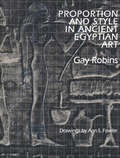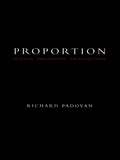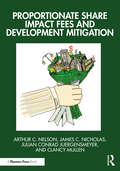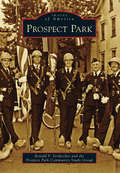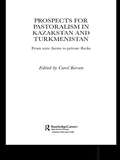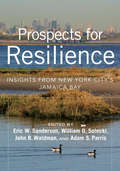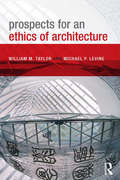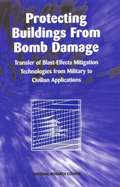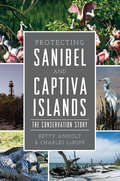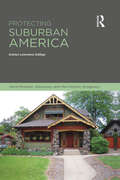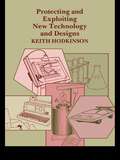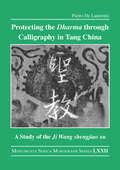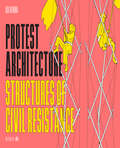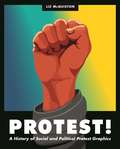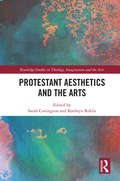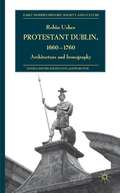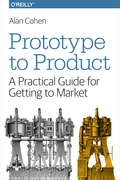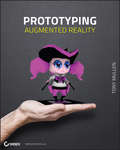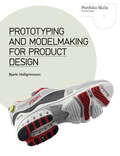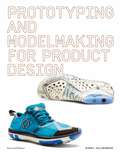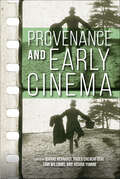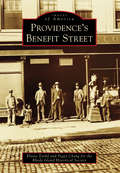- Table View
- List View
Proportion and Style In Ancient Egyptian Art
by Gay RobinsThe painted and relief-cut walls of ancient Egyptian tombs and temples record an amazing continuity of customs and beliefs over nearly 3,000 years. Even the artistic style of the scenes seems unchanging, but this appearance is deceptive. In this work, Gay Robins offers convincing evidence, based on a study of Egyptian usage of grid systems and proportions, that innovation and stylistic variation played a significant role in ancient Egyptian art. Robins thoroughly explores the squared grid systems used by the ancient artists to proportion standing, sitting, and kneeling human figures. This investigation yields the first chronological account of proportional variations in male and female figures from the Early Dynastic to the Ptolemaic periods. Robins discusses in detail the proportional changes underlying the revolutionary style instituted during the Amarna Period. She also considers how the grid system influenced the composition of scenes as a whole. Numerous line drawings with superimposed grids illustrate the text.
Proportion and Style in Ancient Egyptian Art
by Gay RobinsThe painted and relief-cut walls of ancient Egyptian tombs and temples record an amazing continuity of customs and beliefs over nearly 3,000 years. Even the artistic style of the scenes seems unchanging, but this appearance is deceptive. In this work, Gay Robins offers convincing evidence, based on a study of Egyptian usage of grid systems and proportions, that innovation and stylistic variation played a significant role in ancient Egyptian art. Robins thoroughly explores the squared grid systems used by the ancient artists to proportion standing, sitting, and kneeling human figures. This investigation yields the first chronological account of proportional variations in male and female figures from the Early Dynastic to the Ptolemaic periods. Robins discusses in detail the proportional changes underlying the revolutionary style instituted during the Amarna Period. She also considers how the grid system influenced the composition of scenes as a whole. Numerous line drawings with superimposed grids illustrate the text.
Proportion: Science, Philosophy, Architecture
by Richard PadovanThis handbook provides readers with a well-illustrated and readable comparative guide to proportion systems in architecture, setting out the mathematical principles that underlie the main systems and illustrating these with examples of their use in historical and modern buildings. The main body of the text traces the interplay of abstraction and empathy through the history of science, philosophy and architecture from the early Greeks through to the two early twentieth-century architects who made proportion the focus of their work: Le Corbusier and Van der Laan. The book ends with a reflection on the present and future role of proportion in architecture.
Proportionate Share Impact Fees and Development Mitigation
by Arthur C. Nelson James C. Nicholas Julian Conrad Juergensmeyer Clancy MullenAfter decades of evolving practice often tested in court, development impact fees have become institutionalized in the American planning and local government finance systems. But, they remain contentious, especially as they continue to evolve. This book is the third in a series of impact fee guidebooks for practitioners, following A Practitioner’s Guide to Development Impact Fees and Impact Fees: Proportionate Share Development Fees. Proportionate Share Impact Fees and Development Mitigation is the culmination of the authors’ careers devoted to pioneering applications of the dual rational nexus test. That test requires (1) establishing the rational nexus between the need for infrastructure, broadly defined, to mitigate the impacts of development and (2) ensuring that development mitigating its infrastructure impacts benefits proportionately. The book elevates professional practice in two ways. First, it shows how the rational nexus test can be applied to all forms of development infrastructure impact mitigation. Second, it establishes the link between professional ethics and equity as applied to proportionate share impact fees and development mitigation. The book is divided into four parts, with the first reviewing policy and legal foundations, the second detailing the planning, calculation, and implementation requirements, the third exploring economic, ethical, and equity implications, and the fourth presenting state-of-the-art case studies. Proportionate Share Impact Fees and Development Mitigation sets new standards for professional practice.
Prospect Park
by Prospect Park Community Study Group Ronald P. VerdicchioRooted in Dutch traditions, Prospect Park was established in 1901. With a view of what would become the New York City skyline, Prospect Park evolved into a community that placed an emphasis on family values and character. Children would often be seen on the streets jumping rope or playing together at the Hayfields, which later became Hofstra Park. Parents worked locally in the borough and neighboring Paterson, known as "Silk City." Families stopped by Verblaauw's Hardware for household goods and bought produce and flowers at Aiello's, which remains a vibrant business today. Though the borough has undergone an exceptional cultural transformation, Prospect Park has maintained its core values through traditions, cultural practices, and religious observances, with the Prospect Park School remaining the center of community life. New Hope Ministry and the Prospect Park Volunteer Fire Department remain essential to the life of the community. Prospect Park showcases the rich cultural, educational, and economic heritage of this northern New Jersey town.
Prospects for Pastoralism in Kazakstan and Turkmenistan: From State Farms to Private Flocks (Central Asia Research Forum)
by Carol KervenThis collection traces how pastoralists have coped with the challenges of change in a part of the world with a long-tradition of livestock keeping. Their precarious position - balanced between a market system where only the fittest may survive, and their attempt to remain a human resource for the future development of the natural pastures and livestock industry - is carefully and critically examined by the contributors. The pastoralists' unique skills at managing livestock in a variable and challenging environment, and their ability to supply commodities much in demand mean that an understanding of their societal position is essential for anyone interested in transition in the former Soviet Union.
Prospects for Resilience: Insights from New York City's Jamaica Bay
by William D. Solecki John R. Waldman Eric W. Sanderson Adam S. ParrisGiven the realities of climate change and sea-level rise, coastal cities around the world are struggling with questions of resilience. Resilience, at its core, is about desirable states of the urban social-ecological system and understanding how to sustain those states in an uncertain and tumultuous future. How do physical conditions, ecological processes, social objectives, human politics, and history shape the prospects for resilience? Most books set out "the answer." This book sets out a process of grappling with holistic resilience from multiple perspectives, drawing on the insights and experiences of more than fifty scholars and practitioners working together to make Jamaica Bay in New York City an example for the world.Prospects for Resilience establishes a framework for understanding resilience practice in urban watersheds. Using Jamaica Bay--the largest contiguous natural area in New York, home to millions of New Yorkers, and a hub of global air travel with John F. Kennedy International Airport--the authors demonstrate how various components of social-ecological systems interact, ranging from climatic factors to plant populations to human demographics. They also highlight essential tools for creating resilient watersheds, including monitoring and identifying system indicators; computer modeling; green infrastructure; and decision science methods. Finally, they look at the role and importance of a "boundary organization" like the new Science and Resilience Institute at Jamaica Bay in coordinating and facilitating resilience work, and consider significant research questions and prospects for the future of urban watersheds.Prospects for Resiliencesets forth an essential foundation of information and advice for researchers, urban planners, students and others who need to create more resilient cities that work with, not against, nature.
Prospects for an Ethics of Architecture
by Michael P. Levine William M. TaylorBringing together the reflections of an architectural theorist and a philosopher, this book encourages philosophers and architects, scholars and designers alike, to reconsider what they do as well as what they can do in the face of challenging times. It does so by exploring the notion that architecture and design can (and possibly should), in their own right, make for a distinctive form of ethical investigation. The book is less concerned with absolutist understandings of the two components of ethics, a theory of ‘the good’ and a theory of ‘the right’, than with remaining open to multiple relations between ideas about the built environment, design practices and the plurality of kinds of human subjects (inhabitants, individuals and communities) accommodated by buildings and urban spaces. The built environment contributes to the inculcation of all sorts of values (good and bad). Thus, this book aims to change the way people commonly think about ethics, not only in relation to the built environment, but to themselves, their ways of thinking and modes of behaviour.
Protecting Buildings From Bomb Damage: Transfer of Blast-Effects Mitigation Technologies from Military to Civilian Applications
by National Research CouncilThis book provides a brief overview of worldwide terrorist activity and reviews technologies and methods for designing blast resistant buildings. These techniques, primarily developed by the military, have applicability and relevance to the design of civilian structures. The volume recommends that a program of applied research and technology transfer be undertaken to hasten the availability and utility of these techniques to the civilian building community.
Protecting Sanibel and Captiva Islands: The Conservation Story (Natural History)
by Betty Anholt Charles LeBuffThe vibrant Sanibel and Captiva Islands are ecological marvels compared to Florida's many overbuilt barrier islands. Development began with the construction of the Sanibel Island Lighthouse in 1884, when only the lighthouse keeper and assistant and their families lived on the island. Noted conservationist Jay N. "Ding" Darling led the charge in preserving the islands' wildlife and natural beauty from the greed of real estate speculators and land developers in the 1930s. Former presidents like Harry Truman and cabinet-level executives worked alongside Sanibel and Captiva residents, setting up preserves and wildlife refuges to guard the integrity of the islands' unique natural blessings, abundant wildlife and aquatic stores. Charles LeBuff and Betty Anholt review the evolution of the islands' conservation ethic and how it perseveres even today.
Protecting Suburban America: Gentrification, Advocacy and the Historic Imaginary
by Denise Lawrence-ZunigaProtecting Suburban America explores the dynamics and conflicts inherent in preserving historic twentieth-century suburban landscapes in America.Bridging architecture, anthropology, planning, and urban studies, its unique approach combines a study of historic preservation with multi-sited ethnographic fieldwork, to shed fascinating light on issues of heritage, preservation, gentrification, class, ethnicity, and contested values in suburbia. These are subjects which reach far beyond the setting of the book’s focus in California to touch on topical debates in cities, suburbia, and gentrifying neighborhoods worldwide.At the heart of the book is a detailed comparative ethnography of preservation practices and the changing landscapes of five suburban cities, where affluent homeowners have begun to restore their early twentieth-century houses in neighborhoods once suffering from decline. Not every neighbor, however, shares the same aesthetic values, and complex dynamics can arise. The study compares experiences in five different cities, and in different long-term, immigrant, and gentrifying populations. Themes revealed include homeowner restoration practices, aesthetic contestations, local advocacy, and public policy, alongside an exploration of the social construction of the historic restoration process, and how homeowners construct ‘historical’ meaning in their homes and neighbourhoods. These are themes with consequences for national and global settings – of interest wherever contested preservation aesthetics and regulations are reshaping older residential neighbourhoods and their social dynamics.
Protecting and Exploiting New Technology and Designs
by K. HodkinsonThe protection of intellectual property rights has become a major concern in recent years. The opportunities being seized, or lost, in areas such as computer software or biotechnology have captured most of the headlines but in every research facility, whatever the subject, there is an increased awareness of the importance to R & D management of a more commercial attitude. Keith Hodkinson has run Government sponsored "professional updating" courses for academic and industrial researchers and business executives. The practical questions raised there and the advice found most useful have all helped to make this guide a down-to-earth source of help which will be of immediate, profitable use to its readers. Appendices to the book as well as giving lists of useful names and addresses to contact also contain examples of draft letters, contracts and record forms and licensing negotiating checklists.
Protecting the Dharma through Calligraphy in Tang China: A Study of the Ji Wang shengjiao xu 集王聖教序 The Preface to the Buddhist Scriptures Engraved on Stone in Wang Xizhi’s Collated Characters (Monumenta Serica Monograph Series)
by Pietro De LaurentisThis is a study of the earliest and finest collated inscription in the history of Chinese calligraphy, the Ji Wang shengjiao xu 集王聖教序 (Preface to the Sacred Teaching Scriptures Translated by Xuanzang in Wang Xizhi’s Collated Characters), which was erected on January 1, 673. The stele records the two texts written by the Tang emperors Taizong (599–649) and Gaozong (628–683) in honor of the monk Xuanzang (d. 664) and the Buddhist scripture Xin jing (Heart Sutra), collated in the semi-cursive characters of the great master of Chinese calligraphy, Wang Xizhi (303–361). It is thus a Buddhist inscription that combines Buddhist authority, political power, and artistic charm in one single monument. The present book reconstructs the multifaceted context in which the stele was devised, aiming at highlighting the specific role calligraphy played in the propagation and protection of Buddhism in medieval China.
Protest Architecture: Structures of civil resistance
by Nick NewmanA complex bamboo pyramid to block a busy crossing in London. A maze of 'mini Stonehenge' brick structures to hinder government crackdowns in Hong Kong. The takeover of a Dallas highway to create a temporary public square.Architects have often used their skills in struggles for civil rights, gender equality and climate justice. Illuminating the role that design has played in protest movements, Nick Newman explores the colliding worlds of architecture and activism through the stories of those who have built for change.Using historic and contemporary examples, Protest Architecture analyses the design problems and solutions faced by protestors on the streets through detailed drawings, photography and expert insight.From beacons to barricades, towers to treehouses, this unique design typology demonstrates architectural influence over moments of societal change.This is a retelling of protest history through the eyes of an architect.
Protest!: A History of Social and Political Protest Graphics
by Liz McQuistonAn authoritative, richly illustrated history of six centuries of global protest artThroughout history, artists and citizens have turned to protest art as a means of demonstrating social and political discontent. From the earliest broadsheets in the 1500s to engravings, photolithographs, prints, posters, murals, graffiti, and political cartoons, these endlessly inventive graphic forms have symbolized and spurred on power struggles, rebellions, spirited causes, and calls to arms. Spanning continents and centuries, Protest! presents a major new chronological look at protest graphics.Beginning in the Reformation, when printed visual matter was first produced in multiples, Liz McQuiston follows the iconic images that have accompanied movements and events around the world. She examines fine art and propaganda, including William Hogarth’s Gin Lane, Thomas Nast’s political caricatures, French and British comics, postcards from the women’s suffrage movement, clothing of the 1960s counterculture, the anti-apartheid illustrated book How to Commit Suicide in South Africa, the “Silence=Death” emblem from the AIDS crisis, murals created during the Arab Spring, electronic graphics from Hong Kong’s Umbrella Revolution, and the front cover of the magazine Charlie Hebdo. Providing a visual exploration both joyful and brutal, McQuiston discusses how graphics have been used to protest wars, call for the end to racial discrimination, demand freedom from tyranny, and satirize authority figures and regimes.From the French, Mexican, and Sandinista revolutions to the American civil rights movement, nuclear disarmament, and the Women’s March of 2017, Protest! documents the integral role of the visual arts in passionate efforts for change.
Protestant Aesthetics and the Arts (Routledge Studies in Theology, Imagination and the Arts)
by Sarah Covington Kathryn ReklisThe Reformation was one of the defining cultural turning points in Western history, even if there is a longstanding stereotype that Protestants did away with art and material culture. Rather than reject art and aestheticism, Protestants developed their own aesthetic values, which Protestant Aesthetics and the Arts addresses as it identifies and explains the link between theological aesthetics and the arts within a Protestant framework across five-hundred years of history. Featuring essays from an international gathering of leading experts working across a diverse set of disciplines, Protestant Aesthetics and the Arts is the first study of its kind, containing essays that address Protestantism and the fine arts (visual art, music, literature, and architecture), and historical and contemporary Protestant theological perspectives on the subject of beauty and imagination. Contributors challenge accepted preconceptions relating to the boundaries of theological aesthetics and religiously determined art; disrupt traditional understandings of periodization and disciplinarity; and seek to open rich avenues for new fields of research. Building on renewed interest in Protestantism in the study of religion and modernity and the return to aesthetics in Christian theological inquiry, this volume will be of significant interest to scholars of Theology, Aesthetics, Art and Architectural History, Literary Criticism, and Religious History.
Protestant Dublin, 1660–1760
by Robin UsherRobin Usherprovides a unique and comprehensive overview of the symbolic infrastructure of the official, Protestant city of Dublin from the Restoration of 1660 down to the middle of the eighteenth century. Through such monuments as churches, statues, government offices and townhouses, as well as the ephemera of public ceremonial, Usher showshow the early-modern urban populace made sense of its institutions, its localities, its amenities, and, indeed, its wider physical and mental worlds. Questioning faddish claims that seventeenth- and eighteenth-century Dublin can be interpreted as 'colonial' in its symbolic meanings, Usher adopts a trans-national perspective, arguing that the cultural horizons of the city's Protestant elites were as much European as British. Protestant Dublincombines anaccessible writingstyle with rigorous archival researchto appeal to anyone with a serious interest in how past societies engaged with the built environment.
Prototype to Product: A Practical Guide for Getting to Market
by Alan CohenProduct development is the magic that turns circuitry, software, and materials into a product, but moving efficiently from concept to manufactured product is a complex process with many potential pitfalls. This practical guide pulls back the curtain to reveal what happens—or should happen—when you take a product from prototype to production.For makers looking to go pro or product development team members keen to understand the process, author Alan Cohen tracks the development of an intelligent electronic device to explain the strategies and tactics necessary to transform an abstract idea into a successful product that people want to use.Learn 11 deadly sins that kill product development projectsGet an overview of how electronic products are manufacturedDetermine whether your idea has a good chance of being profitableNarrow down the product’s functionality and associated costsGenerate requirements that describe the final product’s detailsSelect your processor, operating system, and power sourcesLearn how to comply with safety regulations and standardsDive into development—from rapid prototyping to manufacturingAlan Cohen, a veteran systems and software engineering manager and lifelong technophile, specializes in leading the development of medical devices and other high-reliability products. His passion is to work with engineers and other stakeholders to forge innovative technologies into successful products.
Prototyping Augmented Reality
by Tony MullenLearn to create augmented reality apps using Processing open-source programming language Augmented reality (AR) is used all over, and you may not even realize it. Smartphones overlay data onto live camera views to show homes for sale, restaurants, or historical sites. American football broadcasts use AR to show the invisible first-down line on the field to TV viewers. Nike and Budweiser, among others, have used AR in ads. Now, you can learn to create AR prototypes using 3D data, Processing open-source programming language, and other languages. This unique book is an easy-to-follow guide on how to do it. Guides you through the emerging technology of Augmented Reality (AR) Shows you how to use 3D data with the Processing programming environment and other languages to create AR prototypes for the web, smartphones, Macs, and PCs Helps 3D artists and designers who want to move into the AR market but don't have programming skills Covers the essentials of 3D programming, creating objects for an AR library, building and exporting 3D models, and much more Explains how to interactively link 3D to physical, virtual, and streaming environments Author Tony Mullen is both an artist and a programmer and perfectly suited to explain how to bridge these two worlds, as he so deftly does in Prototyping with Augmented Reality.
Prototyping and Modelmaking for Product Design: Second Edition
by Bjarki HallgrimssonBuilding prototypes and models is an essential component of any design activity. Modern product development is a multi-disciplinary effort that relies on prototyping in order to explore new ideas and test them sufficiently before they become actual products. Prototyping and Modelmaking for Product Designers illustrates how prototypes are used to help designers understand problems better, explore more imaginative solutions, investigate human interaction more fully and test functionality so as to de-risk the design process. Following an introduction on the purpose of prototyping, specific materials, tools and techniques are examined in detail, with step-by-step tutorials and industry examples of real and successful products illustrating how prototypes are used to help solve design problems. Workflow is also discussed, using a mixture of hands-on and digital tools. A comprehensive modern prototyping approach is crucial to making informed design decisions, and forms a strategic part of a successful designer's toolkit.
Prototyping and Modelmaking for Product Design: Second Edition
by Bjarki HallgrimssonNow in its second edition, Prototyping and Modelmaking for Product Design, by practising product development consultant Bjarki Hallgrimsson, is essential reading for both students and design professionals.Prototyping and ModelMaking for Product Design goes behind the scenes to illustrates how prototypes are used to help designers understand problems better, explore more imaginative solutions, investigate human interaction more fully and test functionality so as to de-risk the design process. Following an introduction on the purpose of prototyping, specific materials, tools and techniques are examined in detail, with step-by-step tutorials and industry examples of real and successful products illustrating how prototypes are used to help solve design problems. Workflow is also discussed, using a mixture of hands-on and digital tools.This new edition includes case studies representing technological developments such as prototyping user experience and interactive electronic products, as well as a new expanded section on digital modelmaking tools, including 3D printing and laser cutting.The first chapters of the book explain why prototyping is so important to the design process. The many uses of prototyping will be shown in the context of several comprehensive projects by some of the world's leading design firms.The second part is an introduction to the typical materials used by designers in their prototyping efforts and how to work with them. In all cases, the approach is to use digital and manual tools in a complementary and effective fashion. Tutorials were specifically developed that underline the back and forth of digital and manual ways of working. The emphasis is on the kinds of construction that can be done by the designers themselves. Health and safety is stressed in terms of personal responsibility and awareness.Topics covered include:Definition of prototyping and modelmakingPrototyping as a form of problem solvingModelmakingPhysical and digital prototypesBuidling by hand and using digital technologies
Prototyping and Modelmaking for Product Design: Second Edition
by Bjarki HallgrimssonNow in its second edition, Prototyping and Modelmaking for Product Design, by practising product development consultant Bjarki Hallgrimsson, is essential reading for both students and design professionals.Prototyping and ModelMaking for Product Design goes behind the scenes to illustrates how prototypes are used to help designers understand problems better, explore more imaginative solutions, investigate human interaction more fully and test functionality so as to de-risk the design process. Following an introduction on the purpose of prototyping, specific materials, tools and techniques are examined in detail, with step-by-step tutorials and industry examples of real and successful products illustrating how prototypes are used to help solve design problems. Workflow is also discussed, using a mixture of hands-on and digital tools.This new edition includes case studies representing technological developments such as prototyping user experience and interactive electronic products, as well as a new expanded section on digital modelmaking tools, including 3D printing and laser cutting.The first chapters of the book explain why prototyping is so important to the design process. The many uses of prototyping will be shown in the context of several comprehensive projects by some of the world's leading design firms.The second part is an introduction to the typical materials used by designers in their prototyping efforts and how to work with them. In all cases, the approach is to use digital and manual tools in a complementary and effective fashion. Tutorials were specifically developed that underline the back and forth of digital and manual ways of working. The emphasis is on the kinds of construction that can be done by the designers themselves. Health and safety is stressed in terms of personal responsibility and awareness.Topics covered include:Definition of prototyping and modelmakingPrototyping as a form of problem solvingModelmakingPhysical and digital prototypesBuidling by hand and using digital technologies
Prototyping and Modelmaking for Product Design: Second Edition (essential Reading For Students And Design Professionals, Digital Processes, 3d Printing, Product Development)
by Bjarki HallgrimssonBuilding prototypes and models is an essential component of any design activity. Modern product development is a multi-disciplinary effort that relies on prototyping in order to explore new ideas and test them sufficiently before they become actual products. Prototyping and Modelmaking for Product Designers illustrates how prototypes are used to help designers understand problems better, explore more imaginative solutions, investigate human interaction more fully and test functionality so as to de-risk the design process. Following an introduction on the purpose of prototyping, specific materials, tools and techniques are examined in detail, with step-by-step tutorials and industry examples of real and successful products illustrating how prototypes are used to help solve design problems. Workflow is also discussed, using a mixture of hands-on and digital tools. A comprehensive modern prototyping approach is crucial to making informed design decisions, and forms a strategic part of a successful designer's toolkit.
Provenance and Early Cinema (Early Cinema in Review: Proceedings of Domitor)
by Joanne Bernardi, Paolo Cherchi Usai, Tami Williams and Joshua YumibeRemnants of early films often have a story to tell. As material artifacts, these film fragments are central to cinema history, perhaps more than ever in our digital age of easy copying and sharing. If a digital copy is previewed before preservation or is shared with a researcher outside the purview of a film archive, knowledge about how the artifact was collected, circulated, and repurposed threatens to become obscured. When the question of origin is overlooked, the story can be lost. Concerned contributors in Provenance and Early Cinema challenge scholars digging through film archives to ask, "How did these moving images get here for me to see them?" This volume, which features the conference proceedings from Domitor, the International Society for the Study of Early Cinema, 2018, questions preservation, attribution, and patterns of reuse in order to explore singular artifacts with long and circuitous lives.
Providence's Benefit Street (Images of America)
by Peggy Chang Elyssa Tardif Rhode Island Historical SocietyOfficially established by 1772 for "the benefit of all," Benefit Street is arguably the most historic thoroughfare in Rhode Island. Some of Providence's most prominent families, including the Browns (the namesake of Brown University), built stately homes on Benefit Street's hillside, many of which still stand today. Threatened by years of neglect, the Providence Preservation Society intervened in the 1950s to save the buildings that line the street. Benefit Street has survived the dangers of demolition and now bears witness to disparate time periods and communities. It is the site of important educational and community institutions, including the Rhode Island School of Design, Brown University, the First Baptist Church, and the Providence Athenaeum, the fourth oldest library in the United States. Providence's Benefit Street showcases the rich history of Rhode Island's capital, a tangible history that can be experienced firsthand by walking one mile through the heart of the city.
